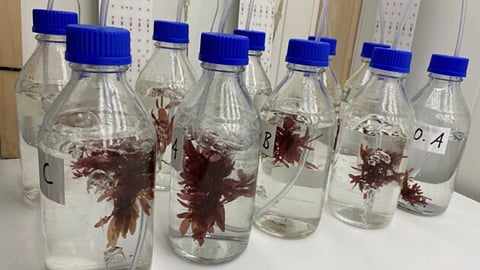

Scientists at the Norwegian Institute of Food, Fisheries and Aquaculture Research (Nofima) have begun investigating the necessary conditions to successfully produce red algae with good growth rates and nice colour in the discharge water from land-based salmon production using recirculating aquaculture systems (RAS).
Nofima senior scientist Philip James and his colleagues conducted a series of trials with dulse (P. palmata), a red algae that has a relatively high value compared to other macroalgae. It is commonly used in food products as a seasoning and can be eaten dried or fresh.
“I think this could be a win-win for both salmon producers, new businesses and the environment”, said James.
In the trial, discharge water from SalMar’s land-based salmon farming facility was used to grow dulse.
The research results showed that dulse grew best on 50 per cent discharge water from RAS from this facility. That is compared to seawater, 25 per cent and 100 per cent discharge water from RAS.
Results also showed that a dilution rate of 50 per cent gave the highest removal efficiency of ammonia and nitrate for this facility. However, for phosphate removal, somewhere between 25 and 50 per cent RAS water was most efficient.
Dulse was also found to have grown equally well in salinity ranging from brackish water to full seawater (equivalent to 10-32 grams salt per kg seawater).
The results showed that for every kilogram of fish feed used in RAS salmon farming, 257 grams of dulse could be produced.
Nofima said that with Norway’s land-based salmon industry consuming around 100,000 tonnes of feed annually, the nutrients in discharge water could provide everything needed for a substantial seaweed industry.
“This underlines the potential for both macroalgae cultivation and utilising RAS nutrients in discharge water as a valuable resource,” said James.
In follow up projects, the scientists will also be testing dulse grown in discharge water from RAS water for nutritional benefits as well as any potential harmful compounds.
"We did compare land-based and sea-based production in our last trial in 2025 and have samples away for biochemical comparison now," added James. "We will now move onto a full comparison of nutrients and PTEs, colour and taste between palmaria grown at sea versus in discharge water in 2026."
